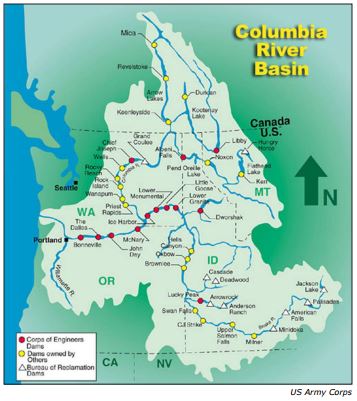By Bill Arthur, Volunteer Columbia-Snake River Campaign, and Julia Reitan, Washington Executive Committee member
The Columbia and Snake rivers were once the greatest salmon rivers in the world with the Snake River producing over half of the more than 16 million salmon that once returned to these waters. The salmon and steelhead supported Native People for millennia and remain an important part of the Northwest culture and economy.
Unfortunately, modification of our river systems from dams, habitat destruction, and other actions over the past 100 years have brought our salmon and steelhead to the brink of extinction. In the Columbia River system, 13 salmonid populations have been listed as threatened or endangered under the federal Endangered Species Act, including all the runs returning to the Snake River.
In the 1960s and 1970s, the last four dams built on the Lower Snake River created a particularly lethal corridor for the salmon. Removing these dams is the single best action we can take to restore our salmon to the thousands of miles of excellent habitat protected upstream in the high elevation watersheds of southeast Washington, northeast Oregon, and central Idaho. These wild salmon are also an essential food source for our Puget Sound resident Orca.
 Court-ordered action
Court-ordered action
A federal district court has ruled that the federal agency salmon plan is inadequate and illegal. The court ordered the Army Corps of Engineers, Bonneville Power Administration, and Bureau of Reclamation to develop a new plan along with a new, comprehensive environmental impact statement (EIS).
Right now, the U.S. Army Corps of Engineer, Bureau of Reclamation, and Bonneville Power Administration are preparing the EIS on the system operation and maintenance of 14 federal multiple-purpose dams and related facilities located throughout the Columbia River basin.
These agencies will use this EIS process to assess and update their approach for long-term system operations and configuration through the analysis of alternatives and evaluation of potential effects to the human and natural environments.
In 1994, Judge Malcolm Marsh declared, “the system literally cries out for a major overhaul.” This is still the case. Sierra Club and partners believe that the EIS must include a full and fair evaluation of removing the four dams on the lower Snake River, along with an analysis of how to replace the modest amount of power they produce with clean energy: energy efficiency, wind, and solar.
The lead agencies for the EIS are now doing a “scoping” process to determine what should be included in the EIS.
The Sierra Club and partners joined together in a Speak Up for Salmon educational campaign to help provide information to the public about the salmon and dam removal issues as well as the EIS process.
Questions?
- Fact sheets on the Columbia River Basin Dams
- For more information about Speak Up for Salmon, contact Bill Arthur or Julia Reitan.
The world has changed
In a climate-changing world, we need to restore health and resiliency to our ecosystems. Removing the four dams on the Lower Snake River would heal and reopen an important corridor for salmon to get back to high elevation, cold-water streams – a literal salmon sanctuary in a warming world. We also have the ability to replace that power with clean, renewable energy.
In the 50 years since these dams were built, much has changed, and there are new considerations in play:
- The Lower Snake River dams are 45-55 years old and now need billions of dollars in repairs. Yet barge shipping through the dams has fallen by 70% and can be replaced by rail and truck transport. There is no reason to keep tax subsidies flowing to these dams.
- The Northwest has abundant, clean-energy resources. Prices for renewable energy are declining rapidly. Increased energy efficiency along with wind and solar power can more than replace the modest amount of power (about 4% of regional power) lost from dam removal.
- Removing the Elwha dams on the Olympic Peninsula proved that salmon return when dams come down. High-quality Columbia Basin salmon habitat awaits if we undo the lethal corridor of four Lower Snake River dams.
- Climate change is making reservoirs in the Lower Snake River even warmer and more deadly for salmon. Recent research shows that dams are not climate clean. Warm reservoirs emit methane, the most potent of greenhouse gasses.
- Endangered Puget Sound Orca rely on Chinook salmon for food during critical times of the year. The Columbia system represents a critical source of food for Orcas.